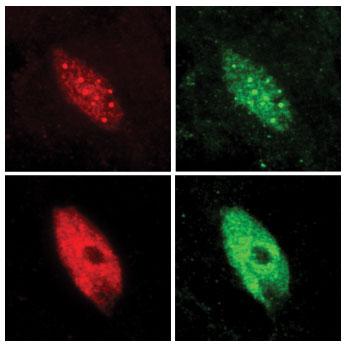Salk scientists find that canopy shade from competing plants triggers cellular changes in as little as five minutes

Credit: Chan Yul Yoo, Meng Chen lab, UC Riverside
LA JOLLA–(June 30, 2021) Scientists–and gardeners–have long known that plants grow taller and flower sooner when they are shaded by close-growing neighbors. Now, for the first time, researchers at the Salk Institute have shown the detailed inner workings of this process.
The study, published June 17, 2021, in Nature Genetics, offers a new understanding of how gene activity directs plant growth, and how quickly plants respond to their environment–with shifting light conditions triggering molecular changes in as little as five minutes. The findings provide insights into how to increase yield and safeguard world food production as climate change shrinks the planet’s arable land.
“This paper shows, in high resolution, how plants respond to subtle environmental changes on the cellular level,” says co-corresponding author Joanne Chory, director of Salk’s Plant Molecular and Cellular Biology Laboratory, Howard Hughes Medical Institute investigator, and holder of the Howard H. and Maryam R. Newman Chair in Plant Biology. “Work that reveals how plants can adapt to greater environmental stresses will be critical as the effects of climate change intensify.”
Plants in the shade grow faster and taller in an effort to break through the canopy and reach more light. At the same time, shaded growing conditions cause them to flower and produce seeds earlier than normal, in order to out-compete other plants. These responses might be helpful to wildflowers growing in a meadow, but on farms they can reduce production and result in bitter, low-quality crops–as any gardener whose lettuce has bolted knows.
In the new study, researchers looked at the role of specific transcription factors in activating this growth response. Transcription factors are proteins that turn genes on or off by binding to DNA.
The team worked with mutant seedlings lacking transcription factors called PIFs (PHYTOCHROME-INTERACTING FACTORs). When they grew these plants in an environment that simulated shade, the plants without certain PIFs did not elongate or speed up their growth, but instead continued to grow normally as if they were in full sunlight. Previously, the Chory lab showed that PIF7 plays the most important role in regulating shade-induced growth.
The researchers then took a closer look at the role of histones in this process, in particular the histone variant H2A.Z. Histones are proteins that act like spools for strands of DNA. When histones are exchanged or modified, they can work to activate or suppress certain genes.
The scientists found that canopy shade led to the removal of the histone H2A.Z at growth-regulating genes through the DNA binding of PIF7, which in turn activated their expression.
By using very short time intervals for their experiments, the researchers found that PIF7 gets activated, binds its target genes, and initiates the removal of H2A.Z, all within the first 5 minutes of the plant experiencing canopy shade.
“Our study describes another step towards a mechanistic understanding of how plants alter their gene expression in response to a changing environment,” says co-corresponding author Joseph Ecker, a Howard Hughes Medical Institute investigator and professor in Salk’s Genomic Analysis Laboratory.
Previous studies had identified PIFs and H2A.Z as having important roles in the responses of plants exposed to high temperatures; however, the timing of events was not known, notes co-author Björn Willige, a Howard Hughes Medical Institute research specialist in the Chory lab.
“Our study reveals the mechanism in close detail and also shows the rapid nature of the response. We found that when PIF7 is active, it binds to DNA. And our data indicate that this leads to the removal of H2A.Z from the DNA. Subsequently, genes are activated, and then this induces growth, to outcompete the neighboring plants,” Willige says.
The speed of the process was unexpected, says co-author Mark Zander, an assistant professor at the Waksman Institute of Microbiology at Rutgers University. He noted that, in addition to triggering the stress response within five minutes, the histone landscape also recovered quickly when shade was removed.
“When we removed shade, the levels of H2A.Z at PIF7 target genes went back to normal within 30 minutes,” he says. “I was surprised by how dynamic the process is, which is really the foundation for the elegance of our study.”
PIFs play significant roles in the growth, development and pest defense of plants. Therefore, the team hopes that their findings can be translated to other plant responses that are important for farmers, especially in relation to helping plants be more resilient to climate change. The Salk Institute’s Harnessing Plants Initiative seeks to help solve climate change by optimizing plants’ natural ability to capture and store carbon.
###
Other authors on the study were Chan Yul Yoo of Oklahoma State University; Amy Phan, Renee M. Garza, Shelly A. Trigg, Yupeng He, Joseph Nery, and Huaming Chen of Salk; and Meng Chen of University of California, Riverside.
The research was supported by the National Science Foundation, the U.S. Department of Energy, the Gordon and Betty Moore Foundation, the National Institutes of Health, the Howard Hughes Medical Institute, the European Molecular Biology Organization, the Human Frontier Science Program and Deutsche Forschungsgemeinschaft.
About the Salk Institute for Biological Studies:
Every cure has a starting point. The Salk Institute embodies Jonas Salk’s mission to dare to make dreams into reality. Its internationally renowned and award-winning scientists explore the very foundations of life, seeking new understandings in neuroscience, genetics, immunology, plant biology and more. The Institute is an independent nonprofit organization and architectural landmark: small by choice, intimate by nature and fearless in the face of any challenge. Be it cancer or Alzheimer’s, aging or diabetes, Salk is where cures begin. Learn more at: salk.edu.
Media Contact
Salk Communications
[email protected]
Original Source
https:/
Related Journal Article
http://dx.




